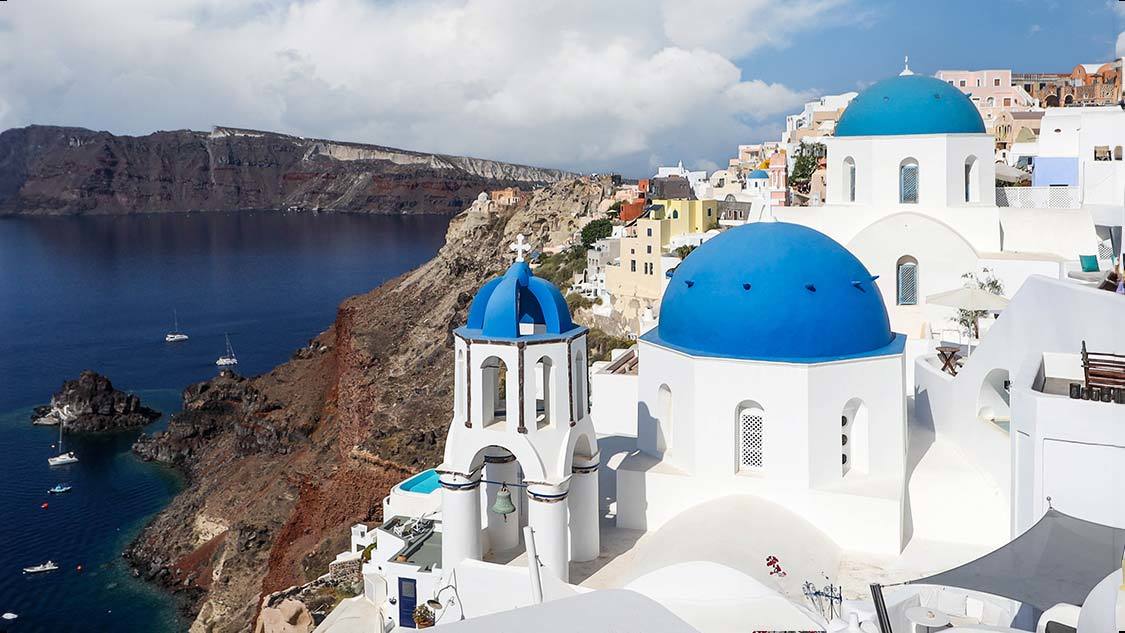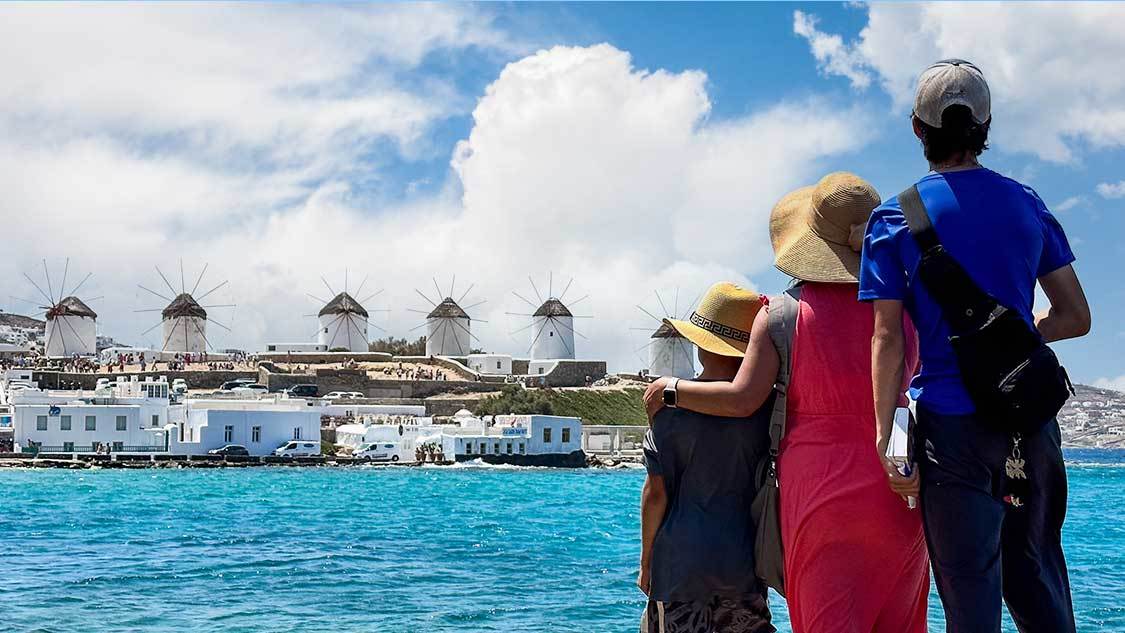Parisian vibes meet ancient Greece in Thessaloniki! Discover a unique blend of history, culture, and stunning scenery in this must-see city. Plan your day in Thessaloniki with these tips!
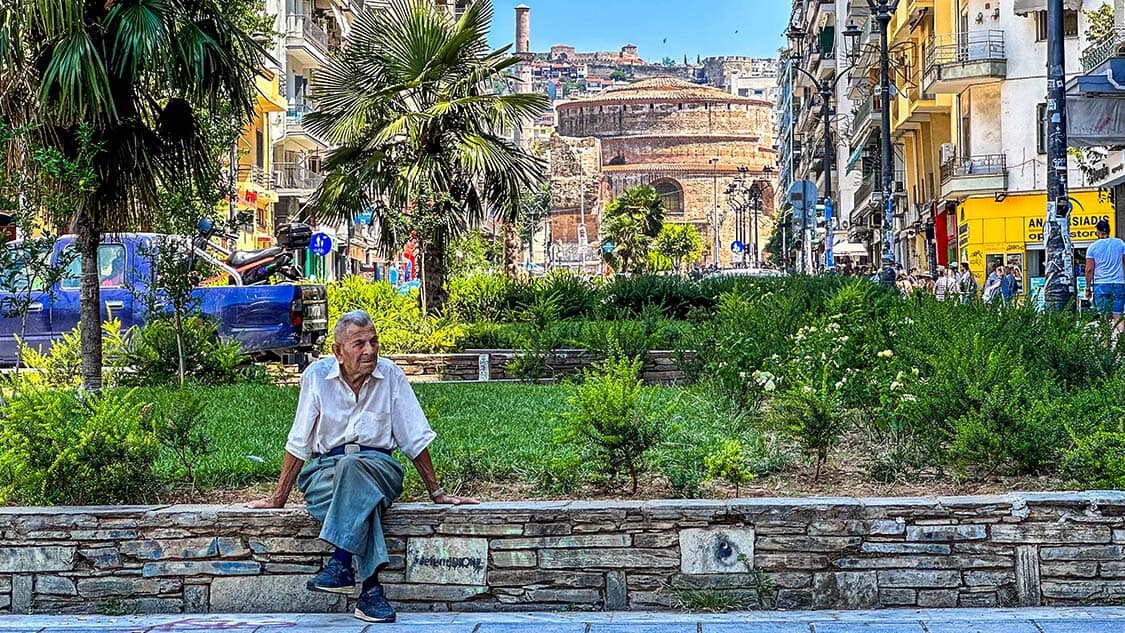
One of the wildest things about being a parent is that if your child gets sick, you can be pretty confident that is exactly how you’re going to feel in about 24-48 hours. And that was exactly what happened when we arrived in Thessaloniki on the second-last day of our Aegean Sea cruise through the Greek Islands.
We had left the islands behind and were spending the final two days of our Celestyal cruise on the mainland. Our first stop was the ancient city of Athens, where we explored Europe’s oldest street, wandered through the Athena Parthenon, and ate more than our fair share of ice cream in the Plaka District.
But the last stop on our cruise would present one of Greece’s most unexpected surprises. Thessaloniki, the second-largest city in Greece., This city was nothing at all like we had expected.
Parisien Waterfront
Table of Contents
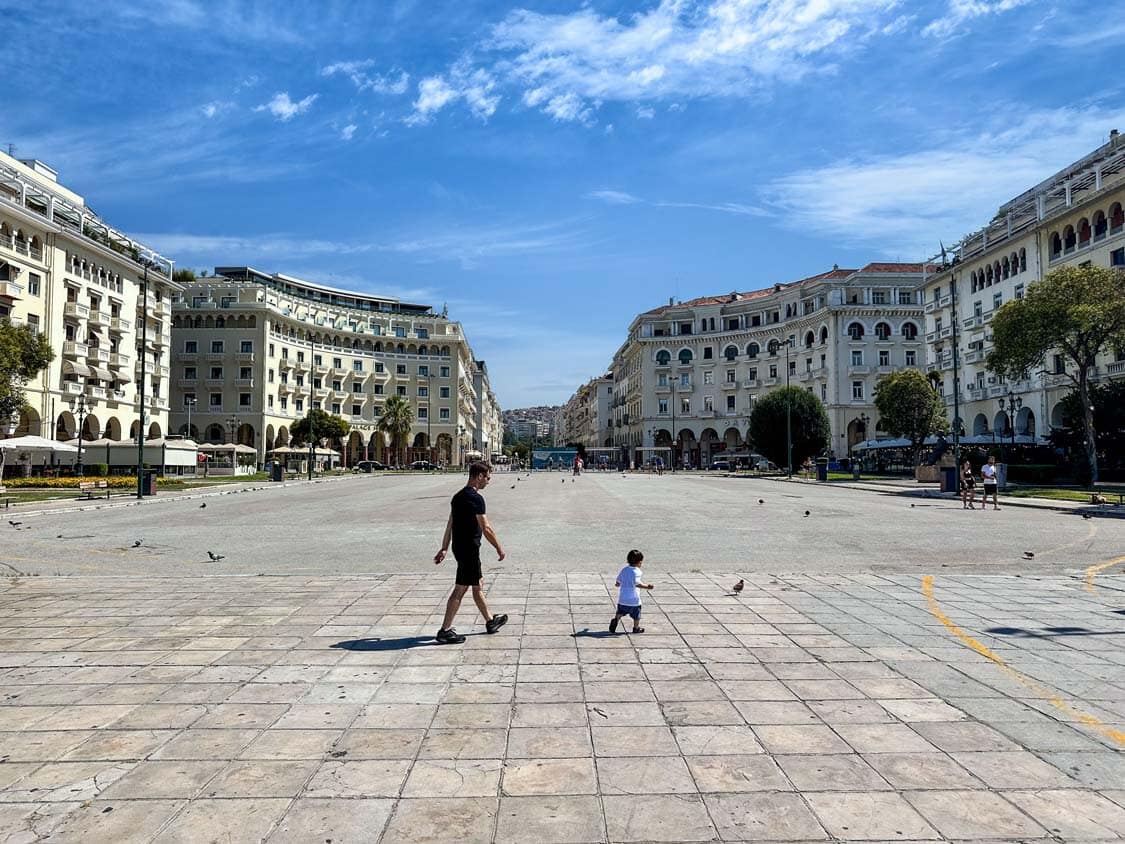
Seven days in the Greek islands, preceded by a 10-day road trip through the Mainland, stopping at iconic places like Mycenae and Delphi along with coastal wonders like Monemvasia and Nafplio. But making the long walk from the port to the waterfront, it was pretty clear that Thessaloniki was nothing like any of the other places to visit in Greece.
Broad boulevards lined with cobblestones worn down by a century of traffic. We strolled down the waterfront promenade, to our right, the glittering Aegean Sea, to our left, the sun was sparkling off tall windows through the bougainvillea-lined balconies.
It wasn’t the chaotic charm of Heraklion, the mystical aura of Delphi, or the postcard-perfect beauty of Oia. This was different. This was…Haussmann-era elegance meets the Aegean. Our first glimpse of the city reeked of Paris. Wide boulevards, reminiscent of the Champs-Élysées (though less grand), lined with cobblestones worn smooth, not by a century of modern life.
The sun glinted off wrought-iron balconies, overflowing with window boxes bursting with crimson geraniums – a touch of Montmartre in the Mediterranean. And there’s good reason for this French flavor. You see, the modern city of Thessaloniki was designed by Ernest Hébrard, the same man who laid the foundations for the city of Paris, France.
Although this is a modern city, through-and-through, dotted throughout these wide lanes, amidst the bakeries and clothing stores, are glimpses of Thessaloniki’s 2,300 years of history. A history that saw this city rise to become the most important city in the Roman Empire outside of Rome itself. A center of power and culture. And my family was here, ready to uncover some of the amazing things to see in this historically significant city.
The White Tower
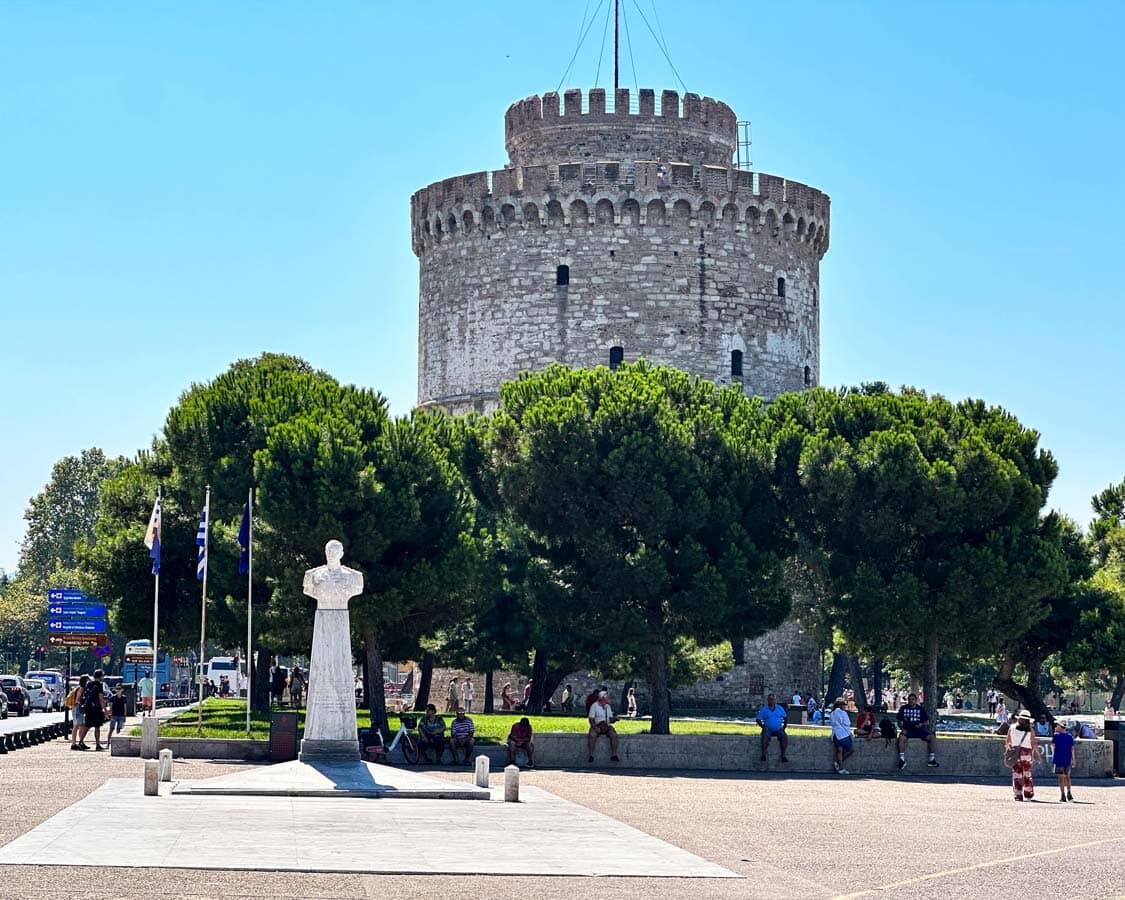
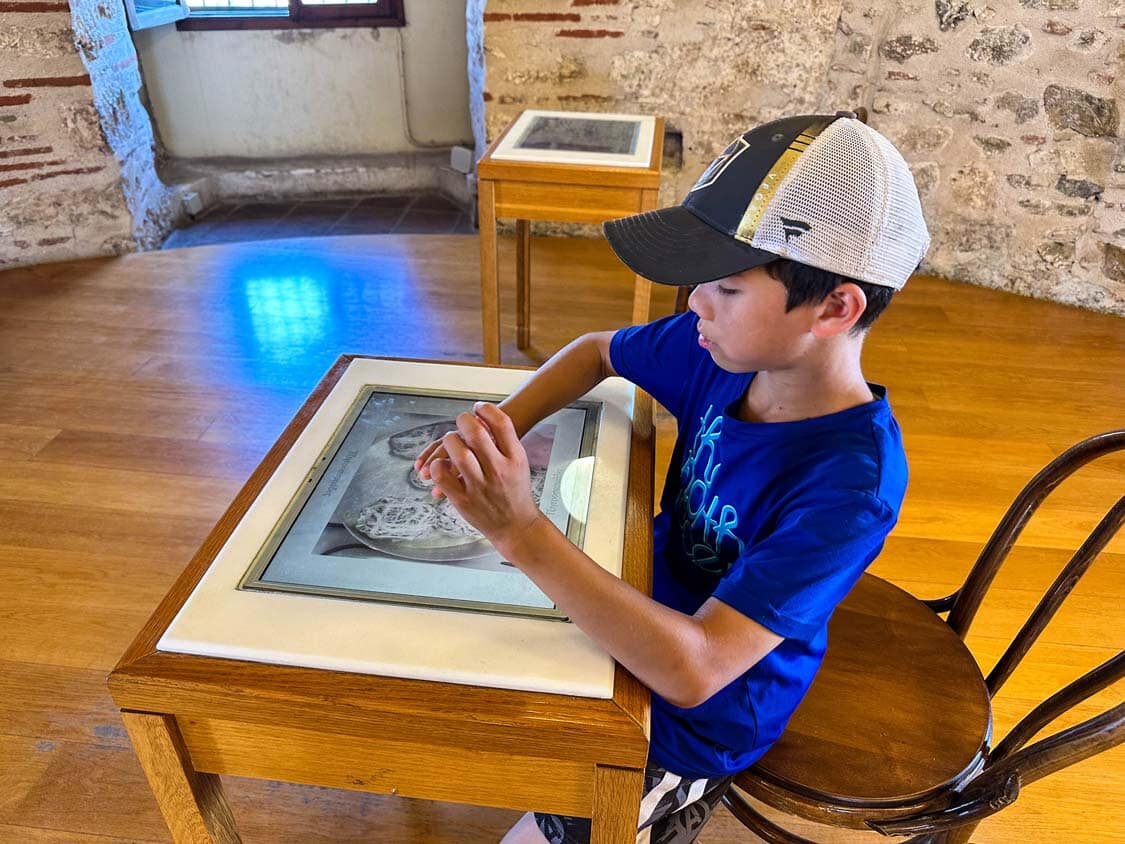
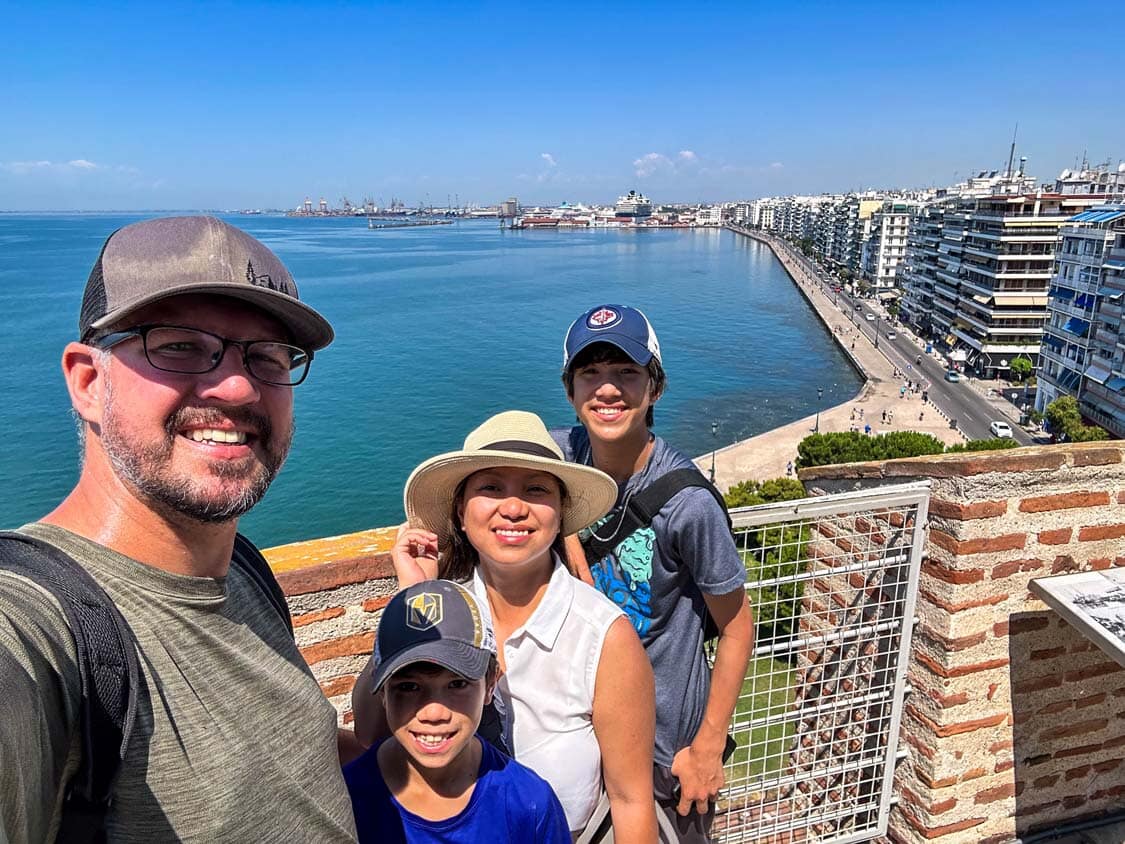
Our meander along the Thessaloniki waterfront was just a leisurely walk, like a stroll along the Seine. In the distance, like a beacon, was one of Thessaloniki’s most important attractions. The White Tower, a sentinel overlooking the lower city and the sprawling waterfront.
Now, it might look like a fortress, but this 131-foot-tall tower has a far more complicated history. It was built in the 15th century by the Ottoman Empire. But before long, its purpose was converted to a prison. This place of incarceration and execution earned it the oppressive nicknames “The Dark Tower” and “The Red Tower,” thanks to the many lives lost and wasted within its walls.
My two ‘intrepid explorers’ (aka, boys who like to climb things) raced ahead, eager to conquer the White Tower. I followed, a little less enthusiastically, thinking about all those poor souls… Inside, rather than bars and terror (or whatever it is that haunts old prisons), they found a museum that showcases the history of the building and of the city it has come to represent. This conversion began in the 19th century, and ironically, it was a prisoner of the tower who led the change.
In exchange for his freedom, he agreed to paint the tower from its dark and ominous facade into a bright, gleaming symbol of hope in the city. Following suit, the city transformed the interior from a place of imprisonment and oppression to a place of enlightenment and education.
We climbed the winding stairs, the cool stone under our feet a stark contrast to the sun-drenched waterfront, and explored the exhibits, the history, and the beauty of the tower, all of it culminating in a broad terrace overlooking the waterfront promenade and the lower city.
And just as we were admiring the breathtaking panorama, celebrating a successful family adventure, our invisible friend from a few days earlier decided to make its presence known. Remember that little fact about sick kids I mentioned earlier? Well, this gorgeous viewpoint, with its stunning vistas of the Aegean Sea, became ground zero for the next wave of our family’s health adventures. Cohen’s Santorini souvenir decided it was time to pay Christina a visit. Right there. With the entire city of Thessaloniki as our witness.
Arch of Galerius
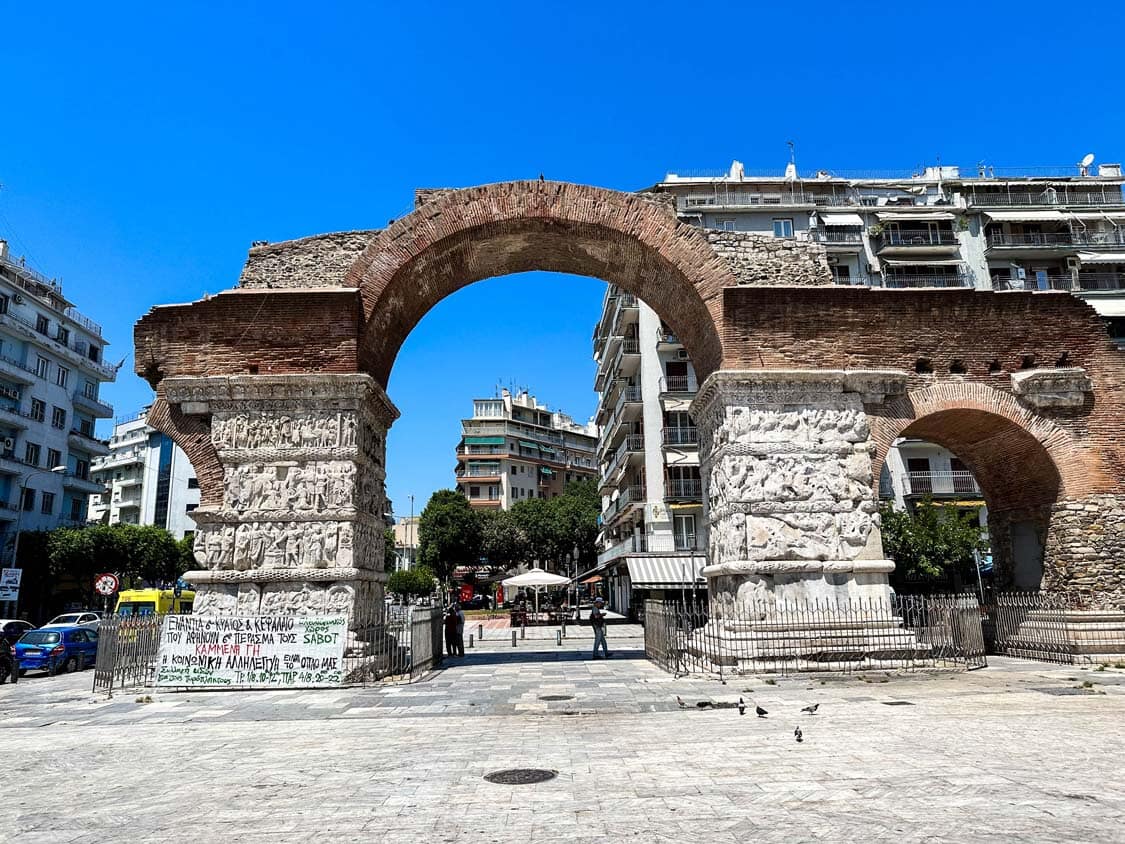
We ambled up Pl. Ippodromiou, pausing at a souvlaki shop and browsing the window displays of shops selling everything from designer handbags to miniature hoplite figurines. Christina trudged along like a soldier, although circulating through varying shades of green along the way.
I even managed to sneak in a quick peek at a bookstore, hoping to find a Greek phrasebook, but the kids were already tugging at my sleeves, eager to explore.
We’d just turned the corner onto Egnatia Street in Thessaloniki, and the Arch of Galerius, or Kamara as the locals call it, stood proudly in the middle of the busy thoroughfare. Standing amidst the modern European apartments, this massive stone archway stood like a portal to another era. It was surrounded by a crumbling wall that had stood the test of time.
The Arch of Galerius was built way back in the 4th century CE to celebrate a Roman Emperor’s victory. It was amazing to think that something so old had survived all these years right here in the middle of a modern city.
As we got closer, the crumbling stone showed its detail, intricate carvings that have survived the weathering of time. Cohen, ever the budding historian (or perhaps just fascinated by anything involving swords), pointed out the depictions of Roman soldiers, peppering me with questions about their armor and weapons.
Walking through the tower arch gave us a unique connection to the past. As we passed through a gate that stood proudly through key moments in world history, we moved beyond the textbook and into real, hands-on world schooling.
Holy Church of Hagia Sophia (No, not THAT Hagia Sophia)
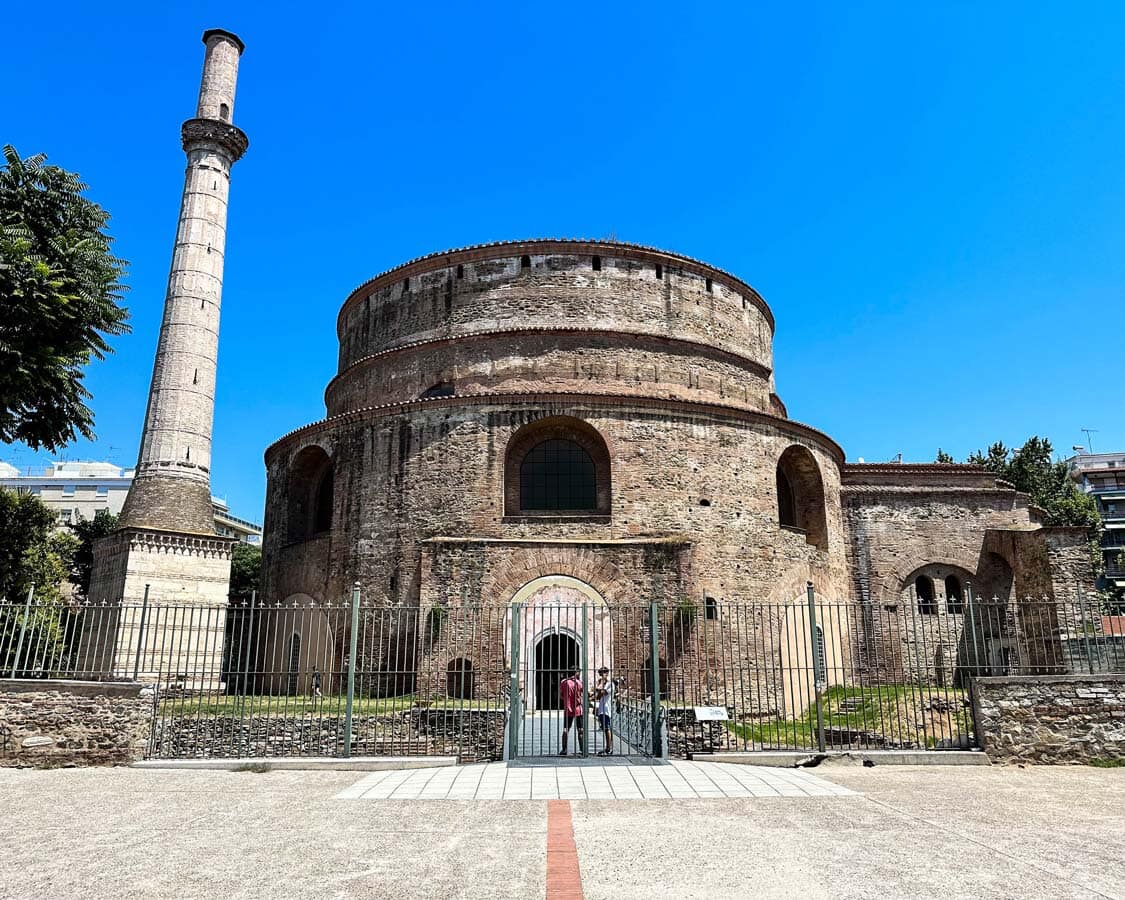
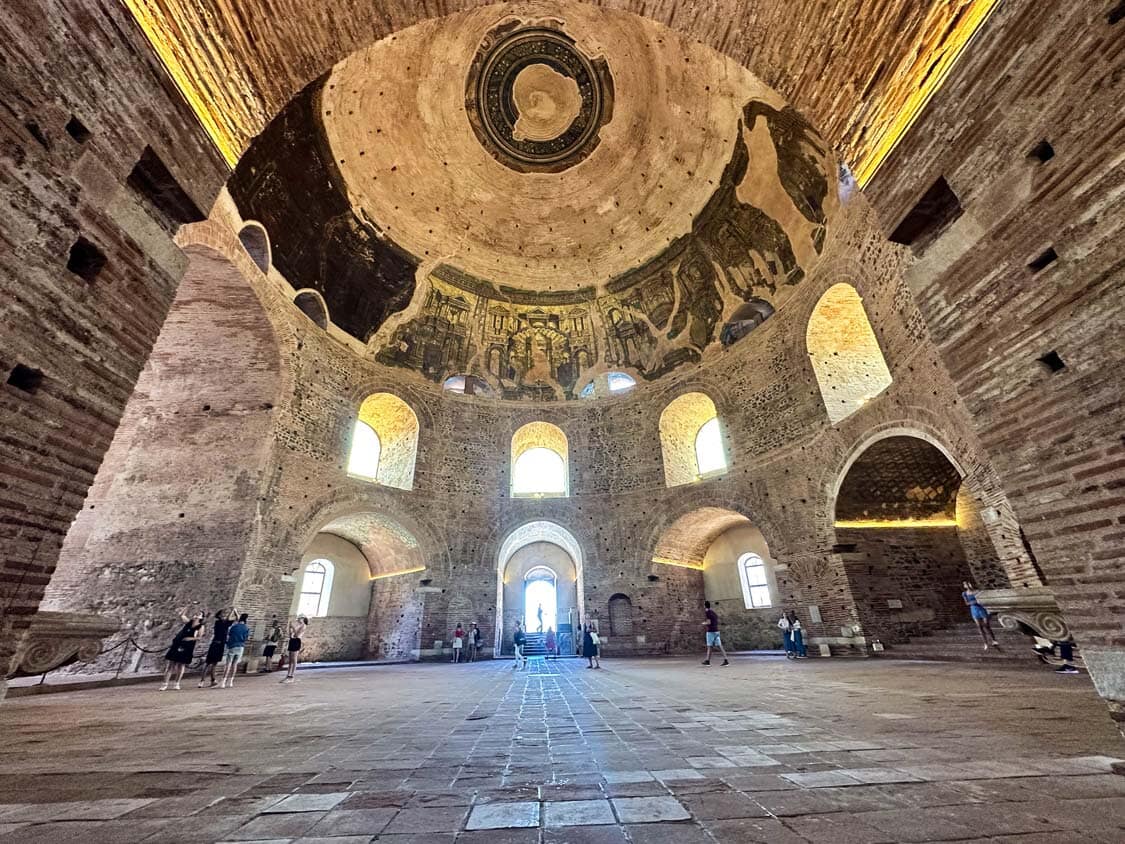
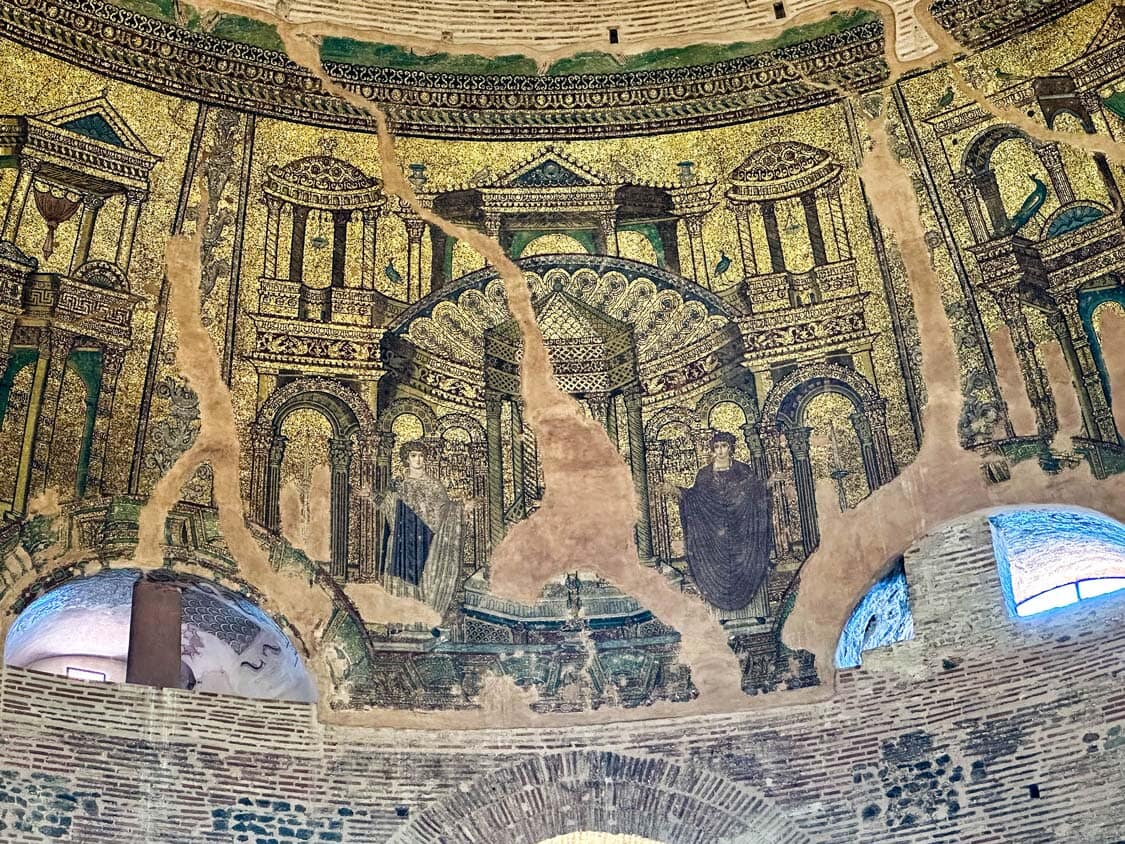
Sitting right next to the Arch of Galerius is one of Thessaloniki’s most famous attractions, the Hagia Sophia. Not the grand, iconic one in Istanbul that we had visited the week before, but Thessaloniki’s own version. A quieter, more subtly powerful presence.
Dylan, ever the architecture critic, declared that this church, while ‘nice,’ didn’t quite have the ‘wow factor’ of its Turkish cousin. ‘It’s more…cozy,’ he offered, as if that were a valid architectural critique. But even he couldn’t deny the deep sense of history that hung in the air.
I knew it had a long and complex past, having served as a church, a mosque, and now a church again, a testament to the city’s layered history. While not as visually impressive, when I told the boys that it predated its more famous namesake in Istanbul, they were floored.
Stepping inside, the atmosphere shifted immediately. The noise of the city faded away, replaced by a sense of quiet reverence. The light filtering through the windows mounted high up within the former church’s domed cathedral illuminated the worn mosaics and frescoes that lined the walls. Some paintings gleamed with their original brilliance, the colors still vibrant after all these centuries. Others were mere ghosts of their former selves, faded and fragmented, like whispers from the past.
The boys huddled around as Christina pointed out some of the key images, depictions of saints, and biblical scenes, and we took a moment to appreciate the artistry and craftsmanship. The towering dome above us, a testament to Byzantine architecture, drew the eye upward. It was a space that felt steeped in history, a place where you could almost feel the weight of centuries of prayers and worship.
Sure, it’s not its big sister. But this place offered us a moment of quiet contemplation amidst the bustle of modern life, a connection to the city’s rich and multifaceted past.
Palace of Galerius and The Roman Forum
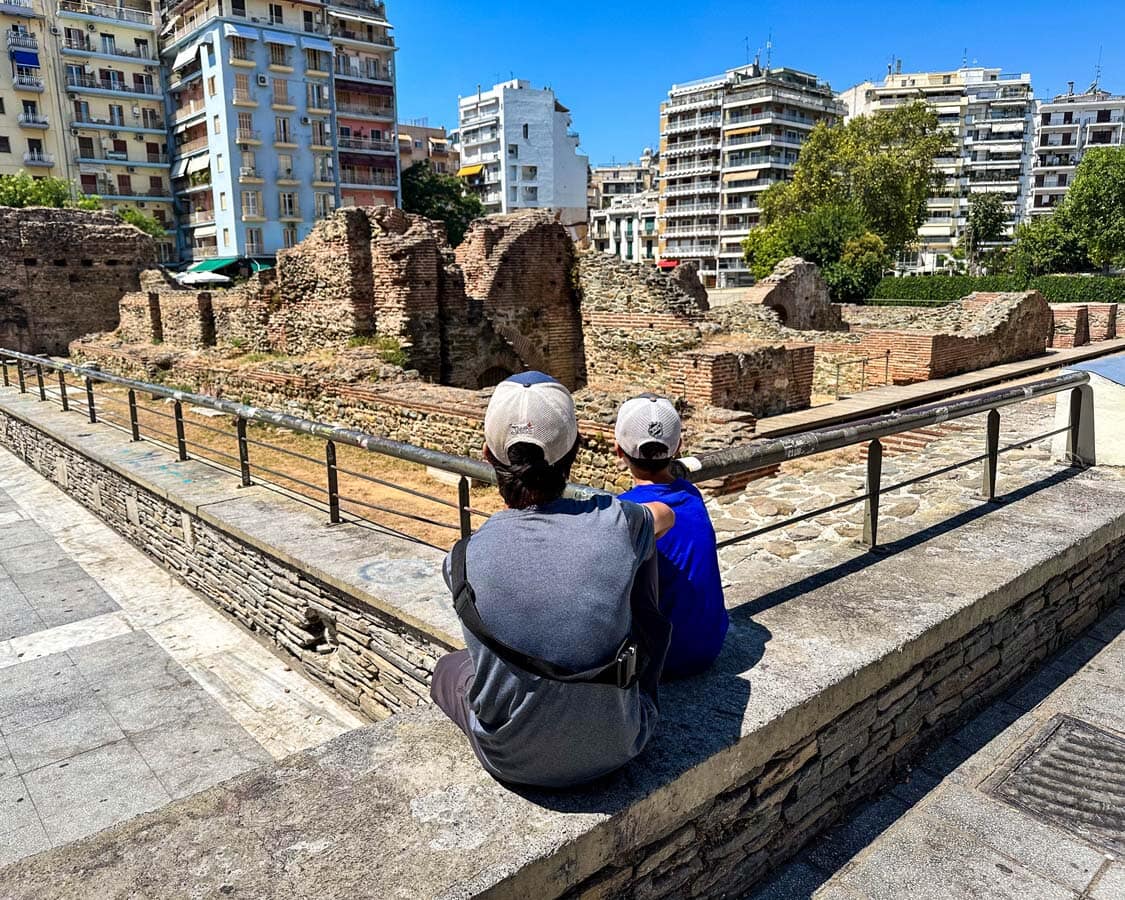
As we began our trek back to the Celestyal Crystal, we stumbled upon an unexpected surprise. Or rather, Dylan, whose radar for ancient ruins is apparently finely tuned, nearly tripped over it. There, lying smack in the middle of a boulevard between Olympou and Filippou, like a forgotten movie set, was a sprawling collection of ruins
Not just any ruins. This was the city’s Roman Forum. A jumble of half-walls, crumbling columns, and doorways that seemed to lead nowhere, all bathed in the afternoon sun. It was less a picture-perfect archaeological site and more a…well, a fascinating mess. But a fascinating mess with history practically oozing from its cracked stones.
The Roman Forum, it turns out, was Thessaloniki’s bustling commercial and administrative center during Roman times. This was where traders, merchants, and citizens went about their daily lives. We could almost hear the echoes of bartering and debates and smell the wafting scent of fresh seafood lingering in the air.
This place was once a flurry of activity. Shops, stalls, and public buildings filled with locals. We explored the excavated corridors and arches, imagining that we were walking among the locals who were here 2,000 years prior.
Saying Goodbye To Thessaloniki and Greece
Our one day in Thessaloniki was just a single bite of a much larger, more delicious meal. A tantalizing glimpse into Thessaloniki, a city that demands further exploration. Like every stop on our seven-day Aegean Sea cruise – Crete, Santorini, Mykonos, Milos, and Athens – it was a fleeting experience, a snapshot in time. But Thessaloniki, with its unique blend of history, culture, and Parisian charm, left a distinct flavor on our palates, a hint of something richer and more complex than we had anticipated.
All of this served to whet our appetite for more places to visit in Greece. This was an entirely different side of the country than we saw during our road trip through the mainland. I can completely understand the draw that drives tens of thousands of visitors to the Greek islands each and every summer.
Thessaloniki may not have topped my ‘must-see Greece’ list, but it left a mark on us. My family learned so much from our brief time there, and I left with a strong desire to return, to delve deeper into its history, to explore its hidden corners, and to experience more of its unique culture.
Thessaloniki is a city that stays with you, a place that sparks your curiosity and leaves you wanting more. And that, I think, is the mark of a truly special destination.
More Things To Do With A Day In Thessaloniki
Vlatadon Monastery
Looking for a peaceful escape from the bustling city? Head up to Ano Poli and discover the Vlatadon Monastery. This isn’t your average monastery – it’s the only active Byzantine monastery in Thessaloniki. It’s also a UNESCO World Heritage Site, which means it’s definitely worth a visit.
Wander through the peaceful gardens, marvel at the ancient frescoes (they’re seriously impressive), and take in the panoramic views of the city sprawling below. Just be warned: the climb up is a bit of a trek, but the view from the top is definitely worth the effort. Think of it as a pilgrimage with a pretty spectacular payoff (and a good excuse for an extra bougatsa afterward).
Heptapyrgion of Thessaloniki
Looking for something a little off the beaten path? The Heptapyrgion (or Yedi Kule) offers a unique glimpse into Thessaloniki’s layered history. This impressive fortress, perched on the acropolis, has served many purposes over the centuries. Originally built in the 14th century (though its origins likely go back even further), it was a key defensive structure for the city. Later, it became the city jail, a role it held for over a century.
Today, as it undergoes restoration, the Heptapyrgion is open to visitors, offering a chance to explore its ramparts, learn about its intriguing past, and enjoy some truly spectacular panoramic views of Thessaloniki. Keep an eye out for exhibits and cultural events – they often take place within the fortress walls, adding another layer of interest to your visit.
Pasha’s Gardens
Feeling adventurous? Pasha’s Gardens, a bit of a hidden gem (about a 30-minute walk from the city center), offers a quirky escape from the usual tourist trail. Imagine strolling through a peaceful park where ancient Ottoman ruins mingle with lush greenery and a touch of Gaudi-esque whimsy. Yes, you read that right. There’s a stone fountain that looks like it belongs in Barcelona and a tunnel that leads…well, nowhere.
It’s all delightfully strange. While the ruins whisper tales of a long-ago era, the gardens themselves were established in 1904, adding another layer to the park’s eclectic charm. If you’re looking for something unusual and don’t mind a bit of a walk, Pasha’s Gardens is definitely worth the trek. Plus, the views of the city are pretty spectacular, too.
Tips For Visiting Thessaloniki
Visiting Thessaloniki (even if it’s just for a day) can be a brilliant step into an exciting Greek city. But just like any new place, it’s good to have a little knowledge before you go. Here are a few tips to help you plan your visit.
- Embrace the Contrasts: Thessaloniki is a city of contrasts. Ancient ruins stand proudly next to modern apartments, Byzantine churches nestle among bustling markets, and Parisian-style boulevards lead to the sparkling Aegean Sea. Don’t be surprised by the unexpected; embrace the city’s multifaceted personality. It’s all part of its charm.
- Get Lost (But Just a Little): While the Thessaloniki city center is relatively easy to navigate, don’t be afraid to wander off the main streets and explore the smaller alleyways, especially in Ano Poli (the Upper City). You might stumble upon hidden gems, charming cafes, or breathtaking views. Just be sure to have a map (or a reliable phone with a local eSim) handy, just in case you get too lost. (Trust me, it happens.)
- Food is Your Friend: Greek cuisine is a gift to the world, and Thessaloniki is a foodie paradise. From bougatsa for breakfast to fresh seafood for dinner, your taste buds are in for a treat. Don’t be shy – try the local specialties, ask for recommendations, and embrace the Greek love of food. And if you see a bougatsa shop, go in. You won’t regret it.
- Prepare for Hills (Especially in Ano Poli): Thessaloniki is built on a hillside, which means there are a lot of ups and downs, especially in the charming but hilly Ano Poli. Wear comfortable shoes, be prepared for some climbing, and consider taking the bus or a taxi if you’re not up for the trek. The views from the top are worth the effort, though!
- Embrace the “Siga-Siga” Attitude: Greeks have a relaxed approach to life, known as “siga-siga” (slowly-slowly). Don’t be surprised if things move at a slightly slower pace than you’re used to. Embrace it! Take your time, savor your coffee, enjoy the sunshine, and soak in the Mediterranean atmosphere. You’re on vacation, after all!
You May Also Like To Read:

